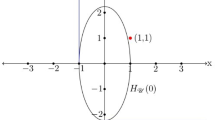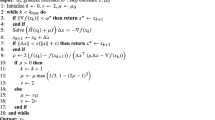Abstract
We introduce a class of structured tensors, called generalized row strictly diagonally dominant tensors, and discuss some relationships between it and several classes of structured tensors, including nonnegative tensors, B-tensors, and strictly copositive tensors. In particular, we give estimations on upper and lower bounds of solutions to the tensor complementarity problem (TCP) when the involved tensor is a generalized row strictly diagonally dominant tensor with all positive diagonal entries. The main advantage of the results obtained in this paper is that both bounds we obtained depend only on the tensor and constant vector involved in the TCP; and hence, they are very easy to calculate.
Similar content being viewed by others
References
Bai X L, Huang Z H, Li X. Stability of solutions and continuity of solution maps of tensor complementarity problems. Asia-Pac J Oper Res, 2019, 36(2): 1940002 (19pp)
Bai X L, Huang Z H, Wang Y. Global uniqueness and solvability for tensor complementarity problems. J Optim Theory Appl, 2016, 170(1): 72–84
Balaji R, Palpandi K. Positive definite and Gram tensor complementarity problems. Optim Lett, 2018, 12(3): 639–648
Che M L, Qi L, Wei Y M. Positive-definite tensors to nonlinear complementarity problems. J Optim Theory Appl, 2016, 168(2): 475–487
Chen H, Qi L, Song Y. Column sufficient tensors and tensor complementarity problems. Front Math China, 2018, 13(2): 255–276
Ding W, Luo Z, Qi L. P-tensors, P 0-tensors, and their applications. Linear Algebra Appl, 2018, 555: 336–354
Du S, Zhang L. A mixed integer programming approach to the tensor complementarity problem. J Global Optim, 2019, 73(4): 789–800
Gowda M S. Polynomial complementarity problems. Pac J Optim, 2017, 13(2): 227–241
Gowda M S, Luo Z, Qi L, Xiu N H. Z-tensors and complementarity problems. arXiv: 1510.07933v2
Guo Q, Zheng M M, Huang Z H. Properties of S-tensors. Linear Multilinear Algebra, 2019, 67(4): 685–696
Han L X. A continuation method for tensor complementarity problems. J Optim Theory Appl, 2019, 180(3): 949–963
Hieu Vu T. On the R 0-tensors and the solution map of tensor complementarity problems. J Optim Theory Appl, 2019, 181(1): 163–183
Hu S, Huang Z H, Wang J. Error bounds for the solution set of quadratic complementarity problems. J Optim Theory Appl, 2018, 179(3): 983–1000
Huang Z H, Qi L. Formulating an n-person noncooperative game as a tensor complementarity problem. Comput Optim Appl, 2017, 66(3): 557–576
Huang Z H, Suo Y Y, Wang J. On Q-tensors. arXiv: 1509.03088v1
Ling L, He H, Ling C. On error bounds of polynomial complementarity problems with structured tensors. Optimization, 2018, 67(2): 341–358
Liu D, Li W, Vong S W. Tensor complementarity problems: the GUS-property and an algorithm. Linear Multilinear Algebra, 2018, 66(9): 1726–1749
Luo Z, Qi L, Xiu N. The sparsest solutions to Z-tensor complementarity problems. Optim Lett, 2017, 11(3): 471–482
Qi L. Symmetric nonnegative tensors and copositive tensors. Linear Algebra Appl, 2013, 439(1): 228–238
Song Y, Mei W. Structural properties of tensors and complementarity problems. J Optim Theory Appl, 2018, 176(2): 289–305
Song Y, Qi L. Properties of some classes of structured tensors. J Optim Theory Appl, 2015, 165(3): 854–873
Song Y, Qi L. Tensor complementarity problem and semi-positive tensors. J Optim Theory Appl, 2016, 169(3): 1069–1078
Song Y, Qi L. Strictly semi-positive tensors and the boundedness of tensor complementarity problems. Optim Lett, 2017, 11(7): 1407–1426
Song Y, Qi L. Properties of tensor complementarity problem and some classes of structured tensors. Ann Appl Math, 2017, 33(3): 308–323
Song Y, Yu G. Properties of solution set of tensor complementarity problem. J Optim Theory Appl, 2016, 170(1): 85–96
Tawhid M A, Rahmati S. Complementarity problems over a hypermatrix (tensor) set. Optim Lett, 2018, 12(6): 1443–1454
Wang J, Hu S, Huang Z H. Solution sets of quadratic complementarity problems. J Optim Theory Appl, 2018, 176(1): 120–136
Wang X, Chen H, Wang Y. Solution structures of tensor complementarity problem. Front Math China, 2018, 13(4): 935–945
Wang Y, Huang Z H, Bai X L. Exceptionally regular tensors and tensor complementarity problems. Optim Methods Softw, 2016, 31(4): 815–828
Wang Y, Huang Z H, Qi L. Global uniqueness and solvability of tensor variational inequalities. J Optim Theory Appl, 2018, 177(1): 137–152
Xie S L, Li D H, Xu H R. An iterative method for finding the least solution to the tensor complementarity problem. J Optim Theory Appl, 2017, 175(1): 119–136
Zhang K, Chen H, Zhao P. A potential reduction method for tensor complementarity problems. J Ind Manag Optim, 2019, 15(2): 429–443
Zhang L, Qi L, Zhou G. M-tensors and some applications. SIAM J Matrix Anal Appl, 2014, 35(2): 437–452
Zhao X, Fan J. A semidefinite method for tensor complementarity problems. Optim Methods Softw, 2018, DOI: https://doi.org/10.1080/10556788.2018.1439489
Zheng M M, Zhang Y, Huang Z H. Global error bounds for the tensor complementarity problem with a P-tensor. J Ind Manag Optim, 2019, 15(2): 933–946
Acknowledgements
This work was supported by the National Natural Science Foundation of China (Grant Nos. 11431002, 11871051).
Author information
Authors and Affiliations
Corresponding author
Rights and permissions
About this article
Cite this article
Xu, Y., Gu, W. & Huang, ZH. Estimations on upper and lower bounds of solutions to a class of tensor complementarity problems. Front. Math. China 14, 661–671 (2019). https://doi.org/10.1007/s11464-019-0770-z
Received:
Accepted:
Published:
Issue Date:
DOI: https://doi.org/10.1007/s11464-019-0770-z
Keywords
- Tensor complementarity problem (TCP)
- generalized row strictly diagonally dominant tensor
- upper and lower bounds of solutions




